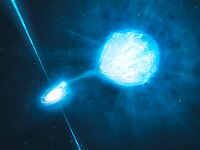
Photo from wikipedia
Long-term viscous neutrino-radiation hydrodynamics simulations in full general relativity are performed for a massive disk surrounding spinning stellar-mass black holes with mass $M_{\rm BH}=4$, $6$, and $10M_\odot$ and initial dimensionless… Click to show full abstract
Long-term viscous neutrino-radiation hydrodynamics simulations in full general relativity are performed for a massive disk surrounding spinning stellar-mass black holes with mass $M_{\rm BH}=4$, $6$, and $10M_\odot$ and initial dimensionless spin $\chi \approx 0.8$. The initial disk is chosen to have mass $M_{\rm disk}\approx 0.1$ or $3M_\odot$ as plausible models of the remnants for the merger of black hole-neutron star binaries or the stellar core collapse from a rapidly rotating progenitor, respectively. For $M_{\rm disk} \approx 0.1M_\odot$ with the outer disk edge initially located at $r_{\rm out} \sim 200$ km, we find that $15$%-$20$% of $M_{\rm disk}$ is ejected and the average electron fraction of the ejecta is $\langle Y_e \rangle = 0.30$-$0.35$ as found in the previous study. For $M_{\rm disk} \approx 3M_\odot$, we find that $\approx 10$%-$20$% of $M_{\rm disk}$ is ejected for $r_{\rm out}\approx 200$-$1000$ km. In addition, $\langle Y_e \rangle$ of the ejecta can be enhanced to be $\gtrsim 0.4$ because the electron fraction is increased significantly during the long-term viscous expansion of the disk with high neutrino luminosity until the mass ejection sets in. Our results suggest that not heavy $r$-process elements but light trans-iron elements would be synthesized in the matter ejected from a massive torus surrounding stellar-mass black holes. We also find that the outcomes of the viscous evolution for the high-mass disk case is composed of a rapidly spinning black hole surrounded by a torus with a narrow funnel, which appears to be suitable for generating gamma-ray bursts.
Journal Title: Physical Review D
Year Published: 2020
Link to full text (if available)
Share on Social Media: Sign Up to like & get
recommendations!